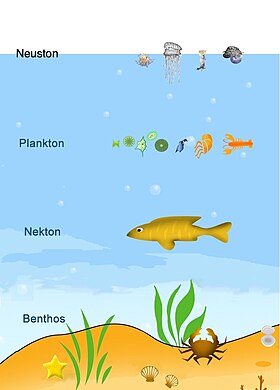Nekton or necton (from the Ancient Greek: νηκτόν, romanized: nekton, lit. 'to swim') is any aquatic organism that can actively and persistently propel itself through a water column (i.e. swimming) without touching the bottom. Nektons generally have powerful tails and appendages (e.g. fins, pleopods, flippers or jet propulsion) that make them strong enough swimmers to counter ocean currents, and have mechanisms for sufficient lift and/or buoyancy to prevent sinking. Examples of extant nektons include most fish (especially pelagic fish like tuna and sharks), marine mammals (cetaceans, sirenias and pinnipeds) and reptiles (specifically sea turtles), penguins, coleoid cephalopods (squids and cuttlefish) and several species of decapod crustaceans (specifically prawns, shrimps and krills).
The term was proposed by German biologist Ernst Haeckel to differentiate between the active swimmers in a body of water, and the planktons that were passively carried along by the current. As a guideline, nektonic organisms have a high Reynolds number (greater than 1000) and planktonic organisms a low one (less than 10). Some organisms begin their life cycle as planktonic eggs and larvae, and transition to nektonic juveniles and adults later on in life, sometimes making distinction difficult when attempting to classify certain plankton-to-nekton species as one or the other. For this reason, some biologists avoid using this term.
History

The term was first proposed and used by the German biologist Ernst Haeckel in 1891 in his article Plankton-Studien where he contrasted it with plankton, the aggregate of passively floating, drifting, or somewhat motile organisms present in a body of water, primarily tiny algae and bacteria, small eggs and larvae of marine organisms, and protozoa and other minute consumers. Today it is sometimes considered an obsolete term because it often does not allow for the meaningful quantifiable distinction between these two groups. The colonization of water column is extremely crucial and important for the evolution of marine animals. During the Devonian Nekton Revolution (DNR) well known as the ‘age of fishes’ accounted more than eighty-five percent of nekton were widespread during the Carboniferous period, that took place during the Paleozoic era. Some biologists no longer use it.
Definition
As a guideline, nekton are larger and tend to swim largely at biologically high Reynolds numbers (>10 and up beyond 10), where inertial flows are the rule, and eddies (vortices) are easily shed. Plankton, on the other hand, are small and, if they swim at all, do so at biologically low Reynolds numbers (0.001 to 10), where the viscous behavior of water dominates, and reversible flows are the rule. Organisms such as jellyfish and others are considered plankton when they are very small and swim at low Reynolds numbers, and considered nekton as they grow large enough to swim at high Reynolds numbers. Many animals considered classic examples of nekton (e.g., Mola mola, squid, marlin) start out life as tiny members of the plankton and then, it was argued, gradually transition to nekton as they grow.
Oceanic nekton
Oceanic nekton comprises aquatic animals largely from three clades:
- Vertebrates (phylum Chordata), particularly pelagic fish, cetaceans and sea turtles, form the largest contribution; these animals have endoskeletons made of bones and cartilages and propel themselves via a powerful tail and fan/paddle-shaped appendages such as fins, flippers or webbed feet.
- Cephalopods (phylum Mollusca), specifically decapodiform coleoids such as squids and cuttlefish, are pelagic nektons that swim using a combination of jet propulsion and fins. Octopodiform coleoids such as octopuses can also swim quite robustly, but they are mostly benthic ambush predators using arms to crawl around.
- Crustaceans (phylum Arthropoda), especially dendrobranchiates and eucarids such as prawns, shrimps and krills can swim actively using specialized legs known as pleopods (a.k.a. swimmerets) and a "tail fan" formed by the telson and uropods. Benthic decapods such as lobsters and crayfish, though normally move around by walking, can also temporarily swim fast backwards as an escape response. Some crab species can also swim in open waters using the last pair of legs (pereiopods) for paddling.
There are organisms whose initial life stage is identified as being planktonic but when they grow and increase in body size they become gradually more nektonic. A typical example is the medusa of the jellyfish, which can actively propel itself (though generally insufficient to overcome strong currents).
See also
- Neuston (organisms, including microscopic, living at the surface of the water)
- Plankton (organisms, including microscopic, floating and drifting within water)
- Benthos (organisms, including microscopic, living at the bottom of a body of water)
References
- Aleyev, Yu. G. (1977). Nekton. doi:10.1007/978-94-010-1324-6. ISBN 978-94-010-1326-0.
- Haeckel, E. 1891. Plankton-Studien. Jenaische Zeitschrift für Naturwissenschaft 25 / (Neue Folge) 18: 232–336. BHL.
External links
- Stefan Nehring and Ute Albrecht (1997): "Hell und das redundante Benthon: Neologismen in der deutschsprachigen Limnologie". In: Lauterbornia H. 31: 17–30, Dinkelscherben, December 1997 E-Text (PDF-Datei)
| Groups of organisms in aquatic ecosystems | |
|---|---|

